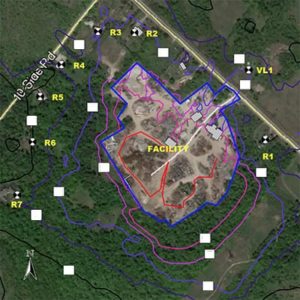Moffatt Scrap Iron & Metal Recycling Facility

Location: Campbellville, Ontario
Owner/Operator: Moffatt Scrap Iron & Metal Inc
Moffatt Scrap Iron & Metal Inc. is located at 9620 Guelph Line in Campbellville, Ontario. The facility is a full-service metal recycling company which purchases, processes, and sells ferrous and non-ferrous scrap metal.
HGC Engineering was retained by Moffatt Scrap Iron & Metal Inc., to update the Acoustic Assessment of their facility. The Assessment is required in support of an application to the Ontario Ministry of the Environment, Conservation and Parks (“MECP”) to amend the Environmental Compliance Approval for the facility. The purpose of this Assessment was to evaluate the sound emissions of the operations under a predictable worst-case operating scenario, which is defined as an hour when typically, busy operation of the stationary sources under consideration could coincide with an hour of low background sound.
Facility Description and Sound Sources
Scrap metal arrives at the facility by truck, is processed on-site and is shipped by truck. The facility operates from 07:00 to 17:00 on Monday to Friday, and 07:00 to 12:00 on Saturdays. Outdoor processing that contributes to the facility’s environmental sound includes unloading of metals from trucks to stockpiles via mobile cranes equipped with grapplers or magnets, sorting, cutting using a mobile shear or torches in some cases, shredding using a stationary hammer-mill, bailing at one of two stationary bailers, and loading of processed scrap onto trucks via crane or front-end loader for outbound shipping. Trucks enter and depart the site via Guelph Line Road.
Potential Points of Noise Reception

The lands to the north and west of the facility have agricultural zoning, while the lands to the south are commercial, and to the east are undeveloped Niagara Escarpment lands. The nearest noise-sensitive points of reception are residences which border the site to the east, and additional residences at 100 to 250 metres north of the site. Information from the Niagara Escarpment Commission indicated that, subject to certain conditions, these lands can host residential uses. Accordingly, a hypothetical residence was considered in the computational model on these lands.
Sound levels of the equipment and activities at the facility were measured HGC Engineering, on-site and near the closest neighboring points of reception. The source sound levels, along with the geometry of the facility and the surrounding area were used to develop a computational acoustical model, in order to prepare a detailed sound source inventory, and thereby determine the contribution of each source to the overall sound levels off-site.
Sound and Vibration Level Limits
The applicable sound level limits at the neighboring noise-sensitive points of reception were established in accordance with MECP Publication NPC-300. The facility-total sound levels were evaluated against the applicable limits.
The measurements and analysis indicate that the sound levels of the facility comply with the limits set out in MECP publication NPC-300. Given the absence of any sources of ground-borne impulse vibration at the site, the facility is also considered to comply with the applicable vibration limits of the MECP. Although the MECP does not have established limits for non-impulsive vibration, the levels of ground-borne non-impulsive vibration measured during operations at the facility were well below the generally accepted limits, and perceptibility threshold, as published by the International Organization for Standardization (ISO).
Acoustical Engineering Services Included:
- An Acoustic Assessment was done to amend the Environmental Compliance Approval for the facility by the Ontario Ministry of the Environment, Conservation and Parks (“MECP”).
- Measurements of stationary sources of sound and vibration at the facility
- A detailed noise and vibration source inventory
- Development of a computational acoustical model

